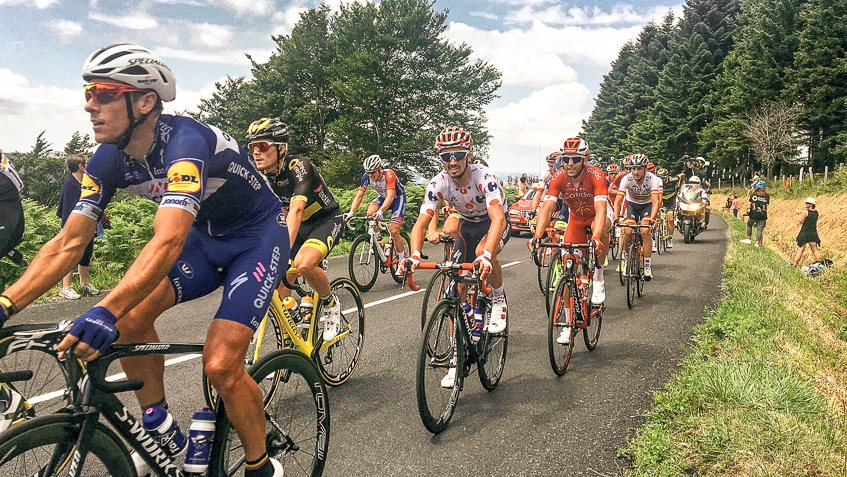Cycling looks so easy and fun when some people are doing it. However, if you observe many beginners and even a fraction of intermediate cyclists, it looks brutal, especially on hilly terrain.
Why is this so? Why is it that you are fit (and muscular) but you cannot seem to ride as far as you would like without getting torturously tired?
The answer lies in your pedal stroke. This part of cycling that appears so simple is more complicated than you think and it needs to be perfected.
Key Takeaways
- Pedaling is a circular motion with four phases: downstroke, backstroke, upstroke, and overstroke. Each phase requires a different amount of power and muscle activation.
- To improve your pedal stroke, you need to practice single-leg exercises that target the muscles used in each phase, such as lunges, deadlifts, and single-leg cycling.
- You also need to build your core strength and endurance with exercises to help you maintain a smooth and efficient pedal stroke over long distances and difficult terrains.
- A proper bike fit is essential for achieving a perfect pedal stroke too. Your saddle height should allow you to pedal in a circle without straining your knees or hips.
- Relaxing and focusing on your posture and foot movement will help you avoid obsessing over the details and enjoy cycling more.
The Perfect Pedal Stroke
Pedaling occurs in a circular motion with four phases or zones; it is not an up and down movement. Think about the face of a clock. The first zone starts from 12 o’clock to 5 o’clock, the second one is from 5 o’clock to 7 o’clock, the third one is from 7 o’clock to 9 o’clock while the fourth and the last starts from 9 o’clock all the way to 12 o’clock. Now you kind of have a picture on your mind, don’t you? Each phase requires a different amount of power.
Okay, it is time to look at each phase separately so you can have a better understanding of the mechanics involved.
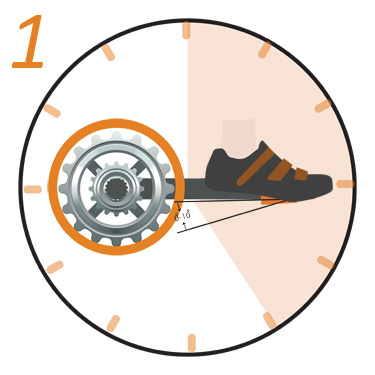
Phase 1 – the Downstroke
This zone is otherwise known as the downstroke or the power phase.
Some experts have said that this is the most important phase in pedaling. It is certainly the one that requires the highest amount of energy.
Think of how you pedal when riding up a hill. You put in a lot of power during this phase. That is how this stroke should be done at all times regardless of the terrain.
You use all your pushing muscles in this stage including the quadriceps, glutes and the hamstrings.
Now many people never think to use the hamstrings during the power phase but it helps to put those powerful muscles into good use.
How do you make sure that all these muscles are properly used?
As you begin from 12 o’clock, incline your foot such that the toes are pointing down (about 200). As you pedal through to 3 o’clock, lower your heel slowly.
By the time you get to 3 o’clock the heel should be parallel to the road (see diagram). Dropping the heel in this phase is key.
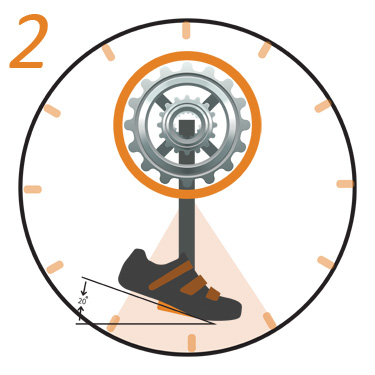
Phase 2 – the Backstroke
This zone is known as the backstroke and it takes over from the downstroke.
It is a short transition phase. You will not be pulling or pushing here; it is a dead spot.
As you can see from the drawing, the toes should be pointing down at an angle of about 200.
The same muscles that are used in the first phase are also used here, but just a little bit.
This zone is all about ankling. Your ankles are put to use here and they get their power from your calf muscles.
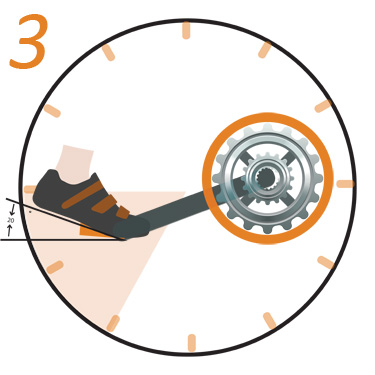
Phase 3 – the Upstroke
This is another short transition phase, the upstroke.
Unlike what many people believe, you do not pull your foot. The pedal does all the work and pushes your foot upwards.
When you are riding on flat terrain, there is no power benefit if you pull up.
However, you should pull up on hilly roads; otherwise, your other leg will be forced to do too much work since it will be in the downstroke phase.
The heel in this zone is raised upwards at 200.
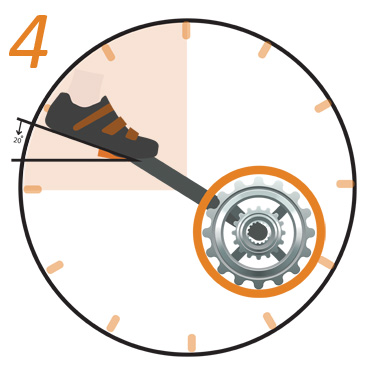
Phase 4 – the Overstroke
This is the phase in which you prepare to enter the power phase. It is known as the overstroke.
Experts say that as soon as you enter this zone, you should start thinking about and preparing yourself for the downstroke. You will not have a smooth pedal stroke or an efficient one if you wait too long to do this.
As you come to 12 o’clock, move your knee slightly towards the handlebar. Try not to move your pelvis during this process. It should be stable.
Raise your heel about 20o.
Exercises That Enhance Your Pedal Stroke and Power
Riding your bike as regularly as you can is a great form of exercise for cyclists. However, it will not help much when you want to improve your pedal stroke. From the pedal stroke phases above, you realize that there are different groups of muscles used. An efficient form of exercise (or exercises) should focus on making these muscles stronger. They should also help you learn how to get out of one phase into another smoothly.
Single-Leg Exercises
In cycling, each leg works alone. When one leg is in the first phase, using so much power, the other one is a little relaxed doing the opposite— have you ever thought about this? Single-leg exercises, therefore, will help your legs learn to work independently. You will be able to activate different sets of muscles in each leg, simultaneously. These exercises also strengthen your core and enhance balance.
Lunges
Lunges are great for cyclists because, just like riding a bike, you focus on a single leg at a given time. Other than that, they target the muscles that you will use in your pedal stroke—the hamstrings, glutes, quadriceps and calf muscles. More importantly, they eliminate any imbalance issues you may have and help you cycle gracefully.
How to do lunges: stand upright and put your right foot in front of the left one. Try to remain as stable as possible (no wobbling or swaying). While still in an upright position, go down until the left knee almost touches the floor and is right behind the right ankle. The left ankle should be pointing up to the sky. Ensure that the front foot is firmly on the floor and that the right knee is at a right angle. Go up and down like ten times then switch legs and repeat the process. Do this for about 15 to 30 minutes.
When you get used to this, add weights for a challenge.
Single-Leg Deadlift
Do not be scared by the fact that this exercise looks a little bit too difficult. Its benefits far outweigh its level of difficulty— it is also not as hard as you think it is. Just like the lunges, a single-leg deadlift leaves all the work for one leg to help eliminate muscle imbalances. You can start with whatever weight you are comfortable with. If you are doing this for the first time, go for 20-40 lbs.
How to do a single-leg deadlift: with your kettlebells in hand, stand upright with your feet close together and your hands straight at either side of your body. Push your left leg back then raise it and your upper body forward. Keep going until the left leg is almost parallel to the floor and the kettlebells are almost touching the floor (close to your right foot). Be sure to bend your right knee a little— this is a very crucial point. Failure to bend the knee will strain your lower back. See video.
Single-leg Cycling
This is one of the best exercises for enhancing your cadence. It trains your mind and muscles to pedal in a circle, smoothly through all the zones, as opposed to pushing down— something that many cyclists do. This drill will greatly improve your efficiency and strengthen the hip flexors. It lets you focus on one leg and analyze its pedal stroke to see what can be done differently. For safety purposes, this activity should be done on an indoor bike trainer. If you are feeling confident you can do it while riding on a flat road; just remember to be careful.
How to do single-leg cycling: set the resistance of your trainer to a moderate level. Rest one foot on a platform, like a chair beside the trainer and start pedaling with the other one. You do not have to pedal at maximum speed; start with whatever is comfortable. Pay attention to the stroke throughout the phases. How smooth is it? Which phase do you find exceptionally challenging? In most cases, it is the upstroke. Try to make it as smooth as you can. Your hip flexors will get worked out very quickly by this, probably because they are weak. Keep at it until you are unable to pedal smoothly due to fatigue. Switch legs and repeat the process. Now cycle with both legs for a few minutes then go back to the drill.
There is another way to do these leg drills, better suited for when you are on the road and not on a trainer. Start pedaling with both feet. Once you are warmed up, either relax one foot completely or unclip it. Let one leg do all the work and aim at having a smooth stroke. When this leg is fatigued start engaging the relaxed/unclipped foot and pedal with both for a few minutes. Repeat the process with the other leg.
Muscle Endurance Exercises
The perfect stroke is not only determined by muscle balance but also by endurance. Your core has to be strong and so do all the other muscles of your body. Only then will you be able to ride over long distances and difficult terrains while maintaining a smooth stroke the entire time. You want to be the kind of cyclists that makes it look easy when everyone else is sweating their backside off. Take a look at some of the exercises that will help you get to that level.
Planks
If you want to build your core strength, planks should be on top of your exercises list. They work your shoulders, lower back and abdomen. There is no need for special equipment or a special room. The good thing about planks is that there is always a way to add some degree of difficulty. They cannot get too old. Also, if you do them religiously you may get enviable abs.
How to do planks: assuming you have a mat ready, lie down straight on your stomach. Next, raise your body such that only your hands, elbows and toes are touching the mat. You can have your hands parallel to each other in front of you (in a fist) or keep them together. Stay in this position for as long as you can. When you get too tired, take a break then do it again. Push your limits each time.
Once your body gets used to this, try a new variation. Instead of remaining still, raise one leg at a time. See how long you can do this. Take a break when you get too tired and come back. Another variation involves leaning on one side. While still in the original position, slowly lean on your right side such that your right elbow is supporting the body and raise your left hand. The oblique muscles will totally feel the burn with this one. Hold on for some time then switch sides. See video.
Squats
This article would not be complete without squats. They work all the right muscles— the hamstrings, quadriceps and hips in addition to boosting muscle endurance. Just like with planks, you will never run out of ways to increase the difficulty of squats. Before you learn how to do squats, it is only right to warn you that you should be careful especially when weights are involved. A wrong move can cause a lot of damage.
How to do squats: stand with your legs wide apart (feet shoulder-width apart). Hold your dumbbells or kettlebells at shoulder height. Lower your body to a sitting position and push your hips back. The ideal position would be when your thighs are parallel to the ground. This may be a little difficult for first-timers but after several attempts, you will get it right. Raise yourself to a standing position. Do as many of these as possible. To make sure the calves are not left out when standing, raise your heels until you are standing on your toes.
Jump Squats
These are like normal squats except there is jumping involved, as the name suggests. You will also not be holding any weight.
How to do jump squats: while in the squat position, stretch out your hands in front of you, parallel to the ground. Instead of just standing up, jump up as high as you can. As soon as you touch the ground, go back to the squat position. Do this repeatedly.
Leg Lifts
This is yet another amazing exercise for strengthening your core and building endurance. It may seem fairly easy but comes with tremendous benefits. It will not take many lifts for you to feel a burn. Other than your core, these lifts work your hip flexors.
How to do leg lifts: lie down straight on your back with your hands stretched out on either side of your body. Lift your legs until they are perpendicular to the ground and lower them— they should come close to touching the ground but not actually touch it. Do as many as you can. When you get burned out, take a break and try again.
A Few Tips to Have in Mind
Make sure that your bicycle is properly set up. A poor bike fit will minimize power, make you uncomfortable or even cause injury. Even if you adhere to everything else above, it will be in vain if you do not get your bike set up.
Your saddle should be set to the right height for you. There is no way to get a smooth pedal stroke with a saddle that is too high for you. A low saddle, on the other hand, will not allow you to pedal in a circle.
Try to relax. There is a lot of science involved in the pedal stroke. Nonetheless, that is not what you should be thinking about when trying to attain the perfect pedal stroke. Do not obsess about the details. Just maintain the right posture and move your feet smoothly in a circle.
A good way to improve your pedal stroke is to use a bike trainer. When your bike is connected to a training stand, you can focus on your stroke, without having to keep an eye out for other traffic.
Bottom Line
You never thought a pedal stroke could be this complicated, right?
All these details are the secret to a smooth pedaling. As soon as you understand the phases, you are halfway there; as long as you apply what you learn.
The single-leg exercises will give you a chance to make sure that each leg is doing everything correctly. The endurance exercises help you keep things going smoothly and (seemingly) easily even when your buddies are struggling to breathe.
If you dedicate yourself to getting the perfect pedal stroke, you will realize what you have been missing. You will never pass on a chance to show off the pro that you will become.

